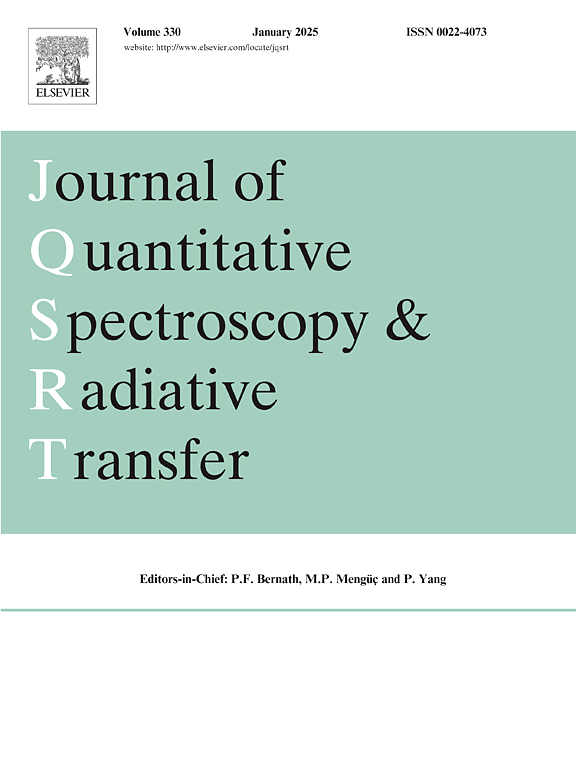Comparative analysis of theories accounting for quantum effects in plasmonic nanoparticles
IF 2.3
3区 物理与天体物理
Q2 OPTICS
Journal of Quantitative Spectroscopy & Radiative Transfer
Pub Date : 2024-11-17
DOI:10.1016/j.jqsrt.2024.109268
引用次数: 0
Abstract
Understanding and accounting for quantum effects in nanoplasmonics is essential for accurate modeling and design of nanophotonic devices. In this paper, we investigate the influence of such quantum effects as spatial nonlocality and splitting of the wave function of conduction electrons near the surface of plasmonic nanoparticles on the extinction cross-section and the field enhancement factor. We apply the theory of generalized nonlocal optical response (GNOR) to describe the spatial nonlocality of noble metal particles. To consider the behavior of electrons near the metal–dielectric interface, mesoscopic boundary conditions are used, including the surface response functions (SRF) - the Feibelman parameters. We use the discrete source method (DSM), allowing for numerical analysis of the scattering problems taking into account quantum effects in the frame of both theories. The application of both GNOR and SRF approaches leads to a decrease in the amplitude of the plasmon resonance compared to the classical Maxwell theory and its shift to the shorter wavelength region (blue shift). The simulation results demonstrate significant differences between the two theories explaining the quantum effects arising in non-spherical plasmonic nanoparticles located in a dense environment. Specifically, compared with GNOR theory, SRF predicts a larger field enhancement. We found that quantum nonlocal effects are more significant for the enhancement factor at the particle surface than for the extinction cross-section. In addition, it was discovered that a denser environment leads to a significant increase in the blue shift of the plasmonic peak.
等离子纳米粒子量子效应理论的比较分析
了解和考虑纳米等离子体学中的量子效应对于纳米光子器件的精确建模和设计至关重要。在本文中,我们研究了等离子纳米粒子表面附近传导电子的空间非局域性和波函数分裂等量子效应对消光截面和场增强因子的影响。我们运用广义非局域光学响应(GNOR)理论来描述贵金属粒子的空间非局域性。为了考虑金属-电介质界面附近电子的行为,我们使用了介观边界条件,包括表面响应函数(SRF)--费伯曼参数。我们使用离散源方法 (DSM),在两种理论的框架内考虑量子效应,对散射问题进行数值分析。与经典麦克斯韦理论相比,GNOR 和 SRF 方法的应用导致等离子体共振幅度减小,并向短波长区域移动(蓝移)。模拟结果表明,在解释位于高密度环境中的非球形等离子纳米粒子所产生的量子效应时,两种理论之间存在显著差异。具体来说,与 GNOR 理论相比,SRF 预测的场增强更大。我们发现,与消光截面相比,量子非局部效应对粒子表面的增强因子更为重要。此外,我们还发现,较稠密的环境会导致等离子峰的蓝移显著增加。
本文章由计算机程序翻译,如有差异,请以英文原文为准。
求助全文
约1分钟内获得全文
求助全文
来源期刊
CiteScore
5.30
自引率
21.70%
发文量
273
审稿时长
58 days
期刊介绍:
Papers with the following subject areas are suitable for publication in the Journal of Quantitative Spectroscopy and Radiative Transfer:
- Theoretical and experimental aspects of the spectra of atoms, molecules, ions, and plasmas.
- Spectral lineshape studies including models and computational algorithms.
- Atmospheric spectroscopy.
- Theoretical and experimental aspects of light scattering.
- Application of light scattering in particle characterization and remote sensing.
- Application of light scattering in biological sciences and medicine.
- Radiative transfer in absorbing, emitting, and scattering media.
- Radiative transfer in stochastic media.

 求助内容:
求助内容: 应助结果提醒方式:
应助结果提醒方式:


